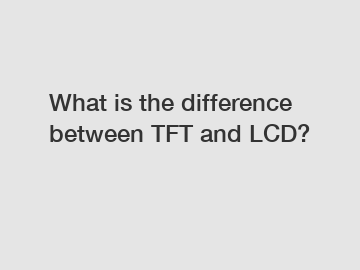Feb. 03, 2024
Electronic Components & Supplies
If you are looking for more details, kindly visit Highlystar.
What is the difference between TFT and LCD? .
When it comes to display technologies, TFT and LCD are terms that are often used interchangeably, but they are not exactly the same thing. TFT (Thin Film Transistor) is actually a type of LCD (Liquid Crystal Display), but not all LCDs are TFTs. So, what exactly sets them apart? Let's explore the differences between these two popular display technologies.

Firstly, let's understand what a Liquid Crystal Display (LCD) is. LCDs have been around for a while and are widely used in various devices, including televisions, computer monitors, smartphones, and more. LCDs use liquid crystal molecules to control the passage of light. In simple terms, an LCD consists of two polarized glass panels, with a layer of liquid crystal material in between. This material can be manipulated by an electric current, enabling the LCD to control the amount and intensity of light passing through.
Now, let's delve into TFT, a specific type of LCD. TFTs utilize thin film transistors, which are essentially tiny electronic switches that are embedded onto each pixel on the glass panel. These transistors act as individual gatekeepers, regulating the flow of electric current to each pixel. By providing precise control over each pixel, TFT technology allows for faster response times and improved image quality compared to traditional LCDs.
Moving on to the differences between TFT and non-TFT LCDs, there are a few key points to consider:
1. Image Quality: TFT displays generally offer superior image quality. The inclusion of thin film transistors allows for enhanced color reproduction, wider viewing angles, and higher resolution. Non-TFT LCDs, such as passive matrix LCDs (PMLCDs), are generally limited in terms of image sharpness and color accuracy.
2. Response Time: TFT displays are renowned for their fast response times, making them ideal for applications that require rapid image transitions, such as gaming or watching action-packed movies. Non-TFT LCDs, on the other hand, may suffer from motion blur or ghosting due to slower response times.
3. Power Consumption: TFT displays consume more power compared to non-TFT LCDs. The inclusion of thin film transistors leads to increased power requirements, which can affect the battery life of portable devices. Non-TFT LCDs are generally more power-efficient, making them suitable for devices where power conservation is a priority.
4. Cost: TFT displays tend to be more expensive to manufacture than non-TFT LCDs. The additional components and complex manufacturing processes involved in creating thin film transistors drive up the cost. Non-TFT LCDs, being simpler in design, are relatively more cost-effective.
In summary, while TFT is a type of LCD, there are notable differences between the two. TFT displays offer enhanced image quality, faster response times, but consume more power and are generally more expensive to produce compared to non-TFT LCDs. Non-TFT LCDs, on the other hand, are more power-efficient and cost-effective but can lag in terms of image quality and response time. The choice between TFT and non-TFT LCD ultimately depends on the specific requirements and priorities of the intended application.
So next time you come across these acronyms, TFT and LCD, you can confidently differentiate between them and understand their unique characteristics. Whether it's for your next gadget purchase or simply to satisfy your curiosity, knowing the difference between these display technologies can indeed come in handy.
If you are looking for more details, kindly visit our website.
If you want to learn more, please visit our website custom lcd display cost.
Previous: Impressive Imposa LED Displays: Lighting up Innovations?
Next: Which is the top TPS4H160BQPWPRQ1 supplier for B2B purchase?
If you are interested in sending in a Guest Blogger Submission,welcome to write for us!
All Comments ( 0 )